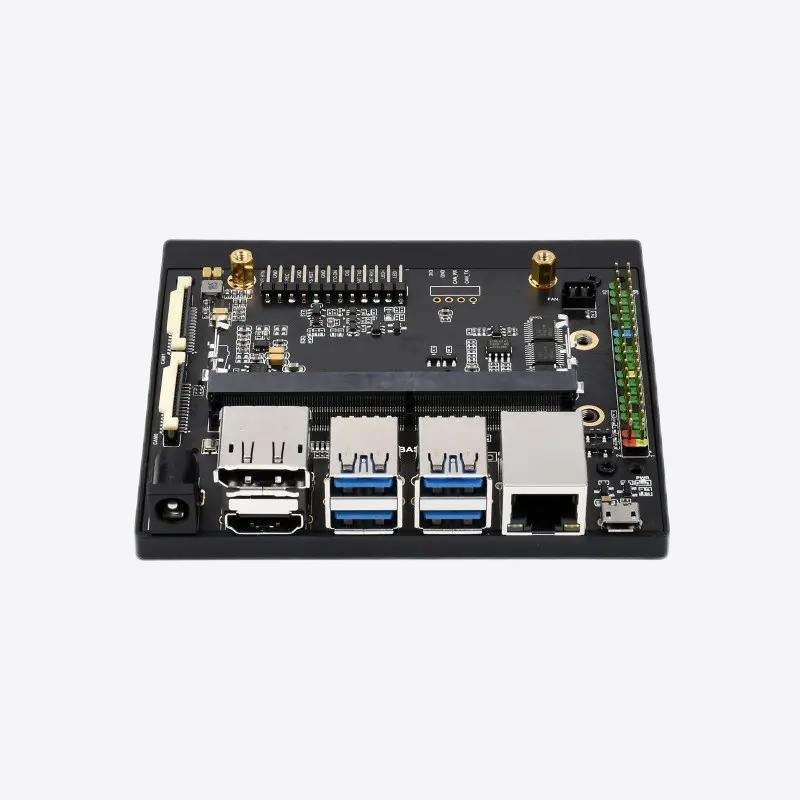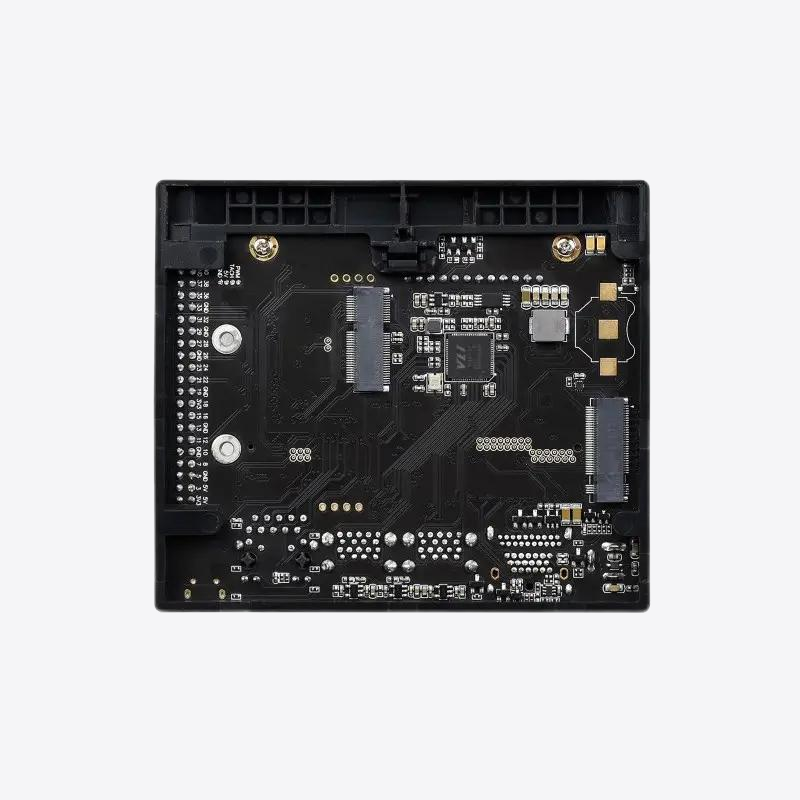Scalable Edge AI Starts with NVIDIA Embedded

How Well Does NVIDIA Hardware Align with Your AI Workload?
Not every deployment is built for AI at the edge. NVIDIA Mini‑ITX designs are purpose-built for GPU-centric workflows — from thermal flow to CUDA core placement and software stack integration.
| Question | Standard NVIDIA Mini-ITX | Customized NVIDIA Mini‑ITX | Exclusive ODM by MiniITXBoard.com |
|---|---|---|---|
| Can it handle AI inference workloads? | CPU-bound, no onboard GPU | Tuned for ultra-low power, sleep modes | Full-stack deployment with TensorRT, NVSDKs, and BSP preloads |
| Is the thermal design GPU-aware? | General-purpose heatsink/fan | Integrated Wi-Fi/BLE, sensor-ready GPIO | AI thermal simulation + multi-zone heat isolation |
| Does it fit edge enclosures easily? | Oversized footprint, airflow blocked | Preemptive real-time OS, deterministic I/O | Chassis co-design for IP65/IP67, zero fan |
| How does it support power-sensitive sites? | Needs external PSU or ATX | Wide temp, shock, EMC hardened | Smart rail detection, redundant power rails |
Custom NVIDIA-Based Boards for Specialized AI & Vision Tasks
Not every workload demands a discrete GPU or massive compute. But when it does, NVIDIA excels. Here’s how to choose the right Jetson- or Orin-based platform for your next embedded AI system.
Jetson Nano / Orin Nano
Compact AI for Light Edge Inference
Tiny footprint, fanless performance with CUDA cores and NVDLA engines. Perfect for vision-enabled IoT or edge analytics.
Use it when:
- You need AI vision on a power budget under 10W
- Your form factor is tight (e.g. robots, drones)
- Fanless is a must and camera input is high
Jetson Orin NX / AGX Xavier
Balanced Performance for Industrial AI Gateways
Versatile compute with 20–60 TOPS. Supports GPU, CPU, and deep learning tasks across logistics, manufacturing, and surveillance.
Use it when:
- Real-time multi-stream AI is needed (e.g. factories, AGVs)
- You’re combining AI, sensors, and networking
- Long lifecycle and industrial temperature range are required
NVIDIA IGX / Custom GPU-SoC
High-Density Compute for Regulated AI Systems
For robotics, smart healthcare, defense, or autonomous vehicles. GPU-accelerated edge AI with embedded safety and security frameworks.
Use it when
- You require ECC memory, secure boot, and functional safety
- Multiple AI models must run simultaneously
- Compliance with ISO 26262 or IEC 62304 matters

Build with Confidence on a Custom NVIDIA Platform
Your workload isn’t generic—and neither is our hardware. Whether you’re building AI vision systems, industrial robots, or high-throughput analytics nodes, we’ll configure your NVIDIA platform to match your exact specs: from Jetson form factor and thermals to BOM freeze and deployment-ready firmware.
- Tuned for GPU + NPU synergy
- Designed to operate at full AI capacity, 24/7
- Locked-in hardware and software lifecycle
Designed for Edge AI, Vision, and Autonomous Systems
NVIDIA Jetson platforms aren’t generic boards—they’re the backbone of GPU-driven inference at the edge. Each I/O configuration is shaped to accelerate computer vision, real-time control, and AI offload without needing external converters or custom hacks.
| Interface Category | Jetson Nano / TX2 NX | Jetson Xavier NX | Jetson Orin NX / Orin Nano |
|---|---|---|---|
| AI Camera Channels | 2x MIPI CSI-2 (lane-sharing) for stereo capture | 6x CSI lanes (3 interfaces, multi-sensor sync) | Up to 8 CSI lanes, concurrent multi-cam with real-time sync |
| Inference Data I/O | USB 3.0 host for AI peripherals | USB 3.1 Gen1 + PCIe Gen3 for neural sensor arrays | PCIe Gen4 x4 + USB 3.2 Gen2 for parallel AI + vision workloads |
| Neural Net Boot Options | eMMC 5.1 + microSD card | eMMC 5.1 + NVMe boot via M.2 Key-M | NVMe + UFS boot options with redundancy & failover built-in |
| Precision GPIO Triggering | 8x GPIO pins (manual timing) | Real-time GPIO with DMA + I2C/SPI | AI-timed GPIO w/ sync pulses for motors, lidar, or conveyor actuation |
| Display & Operator UI | HDMI 2.0 or DSI with backlight control | HDMI + eDP (dual independent displays) | Dual eDP + DSI w/ HDR pipeline, for smart HMIs and ML visual feedback |
| AI Module Expansion | M.2 Key-E for Wi-Fi or edge NPU modules | M.2 Key-M (SSD) + M.2 Key-E (TPU/NPU/5G) | Dual M.2 (GPU accelerator, cellular modem) |
| Audio & Acoustic ML | Analog mic-in + I2S codec support | Multi-channel I2S w/ beamforming mic bus | Smart Audio Engine: NVIDIA AINR + DSP echo cancellation |
| Edge-Grade Power Input | 5–19V DC input, watchdog reset support | 9–20V input w/ voltage lockout & auto recovery | 9–36V industrial input, EMI-filtered, programmable soft-start |
Thermal & Environmental Engineering for GPU-Intensive Deployments
Can Your NVIDIA System Stay Cool While Crunching AI Workloads?
NVIDIA-based Mini-ITX platforms are engineered to keep edge AI, robotics, and high-throughput GPU tasks running under pressure. From rugged enclosures to thermally optimized PCB and component layout, our designs ensure stable operation across challenging environments.
Advanced Heat Pipe Arrays
Custom copper heat pipes and vapor chambers tuned for GPU hotspots — optimized for passive dissipation under full load.
Directed GPU Airflow Zones
PCB zones mapped for targeted airflow across CPU, GPU, and memory modules — fewer fans, smarter ducting.
Intelligent Thermal Throttling Profiles
BIOS- and OS-level thermal tuning using NVIDIA SDK support for predictive cooling control based on workload type.
Rugged Ambient Design
Validated from -10°C to +60°C for edge inference nodes, kiosk A/V, or in-vehicle systems with shock and vibration tolerances.
Power-Efficient AI Acceleration
Thermal envelope optimized to support low-TDP GPU modules (Jetson Orin™, Xavier™) while retaining full CUDA/NPU capacity.


Lifecycle & BOM Confidence for Long-Haul NVIDIA Deployments
In GPU-powered systems, the stakes are higher: firmware changes ripple fast, and unexpected hardware shifts can break AI pipelines. That’s why our NVIDIA platforms are anchored in roadmap visibility, version-controlled AI stacks, and locked-down component sourcing—giving you continuity from prototype to deployment and beyond.
Long-Term Jetson Module Availability
From Jetson Nano to AGX Orin, we align your build with NVIDIA’s industrial SoC lifecycles—ensuring support windows that span 8–10 years with validated carrier board options.
AI Stack Stability & BSP Pinning
We maintain consistent Board Support Packages (BSPs) and CUDA compatibility, avoiding surprise driver updates that disrupt training, inference, or runtime models.
Frozen BOM with Reproducibility
No stealth changes. Every ML-critical part—VRMs, memory ICs, AI accelerators—is frozen and traceable, so your builds behave the same across batches, regions, and revisions.
Real Use of NVIDIA Platforms in AI & Edge Systems
From smart vision to autonomous controls, NVIDIA’s embedded platforms go beyond graphics—they deliver edge intelligence where latency, power, and footprint matter most. Below are real-world functions our Mini-ITX and SOM-based NVIDIA systems are powering today:
GPU-Accelerated Vision AI
Built-in CUDA and Tensor cores process live video for defect detection, OCR, object tracking, and safety zone analytics—without needing a separate GPU card.
Multi-Sensor Fusion & Robotics Control
Synchronize feeds from LiDAR, cameras, and IMUs using real-time Linux + GPU-based parallel compute, ideal for industrial AMRs and robotic arms.
Edge Inference Without the Cloud
Run YOLO, TensorRT, or ONNX models directly on the board with low latency, enabling offline AI in factories, logistics hubs, and smart kiosks.
Power-Conscious AI Deployments
Low TDP options (as low as 10–25W) allow NVIDIA platforms to deliver AI at the edge while staying cool and fanless—perfect for enclosures and remote setups.
Explore Practical Insights for NVIDIA Edge & Embedded Design
Stay ahead with in-depth coverage on Jetson module integration, real-time GPU compute, and field-tested AI deployment tactics—spanning robotics, computer vision, and autonomous infrastructure. Whether you’re building the next smart factory or deploying AI at the edge, our blog delivers the knowledge to do it right.
Intel Celeron N150: Balancing Power, Performance, and Practical Efficiency in Compact Systems
Table of Contents 1. Introduction: The Role of the N150 in Modern Embedded Platforms 2. CPU Microarchitecture and Platform Integration…
Intel Celeron N300: Engineering Low-Power Performance for Modern Embedded Systems
Table of Contents Introduction: The N300’s Place in Embedded and SFF Markets Architecture & SoC Integration Power Consumption & Idle…
